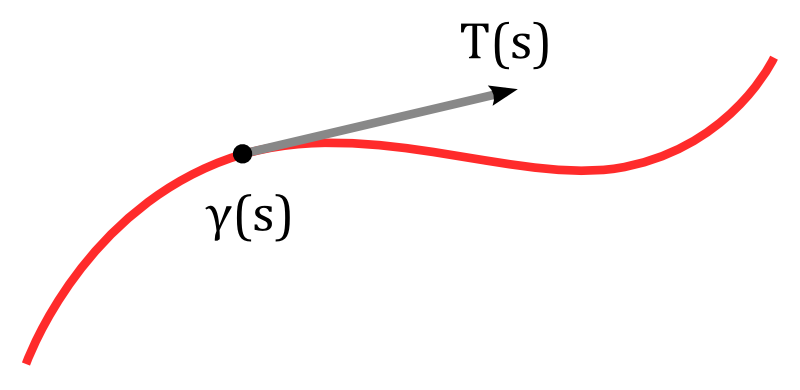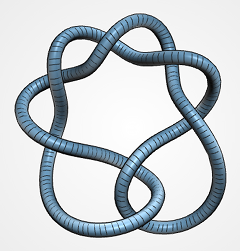A path in $\mathbb{R}^n$ is a $C^\infty$ map
\[\gamma: [a,b] \to \mathbb{R}^n.\]
We imagine $\gamma$ as the path traced out by a moving point $\gamma(t)\in \mathbb{R}^n$ over the time interval $[a,b]$. Such a path $\gamma$ is called regular if $\gamma'(t) \neq 0$ for all $t\in [a,b]$. Suppose we have another path $\tilde{\gamma}: [\tilde{a},\tilde{b}] \to \mathbb{R}^2$ that reaches every point $\gamma(t)$ covered by $\gamma$, only at a different time $\tilde{t}=\varphi(t)$. Thus we have
\[\tilde{\gamma}=\gamma \circ \varphi.\]
We assume that $\varphi$ is $C^\infty$ and maps the interval $[\tilde{a},\tilde{b}]$ diffeomorphically onto $[a,b]$ in an orientation-preserving fashion:
\begin{align*}\varphi(\tilde{a})&=a \\ \varphi(\tilde{b})&=b \\ \varphi’ &>0.\end{align*}
Then we say that $\tilde{\gamma}$ is just a reparametrized version of the same “curve segment”. Thus curve segments are defined as equivalence classes of planar paths. Note that the reversed path
\begin{align*}\tilde{\gamma}:[a,b] &\to \mathbb{R}^2 \\ \tilde{\gamma}(t)&=\gamma(b+a-t)\end{align*}
in general defines a different curve segment. Thus curve segments come with a well defined orientation. They have a definite starting point.
Fortunately, we almost never have to deal with issues of reparametrization. This is because every curve segment has a canonical parametrization, its so-called parametrization by arc length: For a regular path $\gamma:[a,b]\to\mathbb{R}^n$ its length is defined as
\[\mbox{length}(\gamma)= \int_a^b |\gamma’|.\]
Then with the notation $L:=\mbox{length}(\gamma)$ the function
\begin{align*}\ell:[a,b] &\to [0,L] \\ \ell(t)&=\mbox{length}(\gamma|_{[a,t]})\end{align*}
has a smooth inverse $\varphi:[0,L] \to [a,b]$ and $\tilde{\gamma}=\gamma\circ\varphi$ has a velocity vector field $T=\tilde{\gamma}’$ of unit length:
\[|\tilde{\gamma}’|=1.\]
Any path with this property is called an arc length parametrization of a curve in $\mathbb{R}^n$.
A periodic path in $\mathbb{R}^n$ is a pair $(\gamma,\tau)$ where $\gamma: \mathbb{R} \to \mathbb{R}^n$ is $C^\infty$ and $\tau$-periodic, which means that for all $t\in \mathbb{R}$ we have
\[\gamma(t+\tau)=\gamma(t).\]
Again, such a closed path is called regular if $\gamma'(t) \neq 0$ for all $t\in\mathbb{R}$. A smooth map $\varphi: \mathbb{R} \to \mathbb{R}$ such that
\begin{align*}\varphi’&>0\\ \varphi(\tilde{t}+\tilde{\tau})&=\varphi(\tilde{\tau})+\tau\end{align*}
defines a reparametrization $(\tilde{\gamma},\tilde{\tau})$ of $(\gamma,\tau)$. A closed curve in $\mathbb{R}^n$ is an equivalence class of periodic paths with respect to reparametrization.
The length of a closed curve $(\gamma,\tau)$ is defined as the length of the path $\gamma|_{[0,\tau]}$. If $L$ is the length of a regular periodic path $(\gamma,\tau)$ then one can show as before that there is a reparametrization $(\tilde{\gamma},L)$ with $|\tilde{\gamma}’|=1$. Note however that such an arc length parametrization of a regular closed curve is unique only up to a parameter translation: For every $a\in \mathbb{R}$ the periodic path $s\mapsto \hat{\gamma}(s)=\tilde{\gamma}(s+a)$ has the same property.


